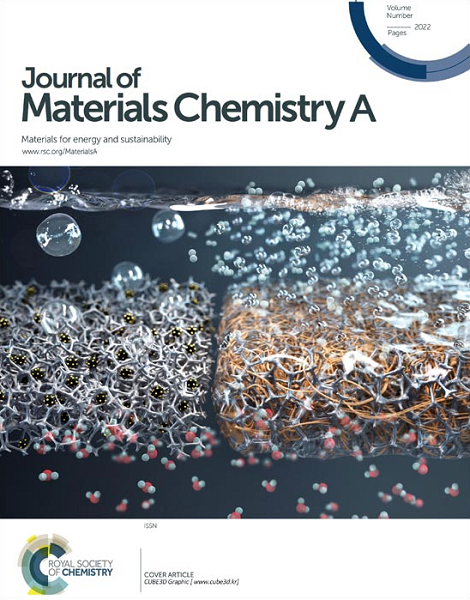通过季铵离子调制电场力和竞争溶剂化制备高放电深度和高电流密度条件下的高可逆锌电池
IF 10.7
2区 材料科学
Q1 CHEMISTRY, PHYSICAL
引用次数: 0
摘要
水性锌离子电池因其安全、理论能量密度高、环境友好等优点,已成为锂离子电池的一个有前途的替代品。然而,一些关键的挑战,如析氢反应(HER)和活性水分子引起的腐蚀,以及高局部电场引起的锌沉积不均匀和枝晶的猖獗生长,严重阻碍了它们的实际应用。在高放电深度(DoD)条件下,锌阳极的可逆性急剧恶化,这些问题变得更加严重。本文介绍了一种有机季铵盐——四氟硼酸四甲基铵(TMA-BF)作为电解质添加剂。理论计算与实验表征相结合表明,TMA+与EDL结合,中和了锌矿床的负电荷。这调节了EDL内部的局部电场力,促进了Zn2+的均匀沉积,并通过静电筛选抑制了枝晶的生长。此外,TMA+与水分子之间的强亲和力通过与Zn2+在溶剂化(竞争性溶剂化)中的竞争改变了氢键网络,有效地减少了活性水分子的数量。因此,改进的ZIBs表现出高可逆性:Zn‖Zn对称电池在2 mA cm−2下实现超过4000小时的稳定循环,在20 mA cm−2下实现超过1400小时的稳定循环。值得注意的是,即使在深度放电条件下(DoD为75%和85%),也能分别保持700和400小时的稳定循环,优于大多数报道的电解质添加剂策略。此外,锌‖MnO2电池在8000次循环后仍能保持92%的容量,锌‖Br2电池在1200次循环后仍能保持84%的容量。最后,组装的袋状电池表现出优异的性能,突出了该策略的实际可行性。本文章由计算机程序翻译,如有差异,请以英文原文为准。

Constructing highly reversible zinc batteries under high depth of discharge & current density conditions via quaternary ammonium cations modulating electric field force and competitive solvation
Aqueous zinc-ion batteries have emerged as a promising alternative to lithium-ion batteries due to their safety, high theoretical energy density, and environmental friendliness. However, several critical challenges – such as the hydrogen evolution reaction (HER) and corrosion induced by active water molecules, as well as the uneven zinc deposition and rampant growth of dendrites caused by high local electric fields – significantly hinder their practical applications. These issues become even more severe under high depth-of-discharge (DoD) conditions, where the reversibility of the zinc anode drastically deteriorates. In this work, we introduce an organic quaternary ammonium salt, tetramethylammonium tetrafluoroborate (TMA–BF), as an electrolyte additive. Theoretical calculations combined with experimental characterization reveal that TMA+ incorporates into the EDL, neutralizing the negative charge of Zn deposits. This regulates the local electric field force within the EDL, promoting uniform Zn2+ deposition and suppressing dendrite growth by electrostatic screening. Furthermore, the strong affinity between TMA+ and water molecules alters the hydrogen-bonding network by competing with Zn2+ in solvation (competitive solvation), effectively reducing the amount of active water molecules. As a result, the modified ZIBs exhibit high reversibility: Zn‖Zn symmetric cells achieve over 4000 hours of stable cycling at 2 mA cm−2 and over 1400 hours at 20 mA cm−2. Remarkably, even under deep discharge conditions (DoD of 75% and 85%), stable cycling is maintained for more than 700 and 400 hours, respectively – outperforming most reported electrolyte additive strategies. Moreover, the Zn‖MnO2 full cell retains 92% of its capacity after 8000 cycles, and the Zn‖Br2 cell also retains 84% of its capacity after 1200 cycles. Finally, the assembled pouch cell exhibited splendid performance, highlighting the practical viability of this strategy.
求助全文
通过发布文献求助,成功后即可免费获取论文全文。
去求助
来源期刊

Journal of Materials Chemistry A
CHEMISTRY, PHYSICAL-ENERGY & FUELS
CiteScore
19.50
自引率
5.00%
发文量
1892
审稿时长
1.5 months
期刊介绍:
The Journal of Materials Chemistry A, B & C covers a wide range of high-quality studies in the field of materials chemistry, with each section focusing on specific applications of the materials studied. Journal of Materials Chemistry A emphasizes applications in energy and sustainability, including topics such as artificial photosynthesis, batteries, and fuel cells. Journal of Materials Chemistry B focuses on applications in biology and medicine, while Journal of Materials Chemistry C covers applications in optical, magnetic, and electronic devices. Example topic areas within the scope of Journal of Materials Chemistry A include catalysis, green/sustainable materials, sensors, and water treatment, among others.
 求助内容:
求助内容: 应助结果提醒方式:
应助结果提醒方式:


